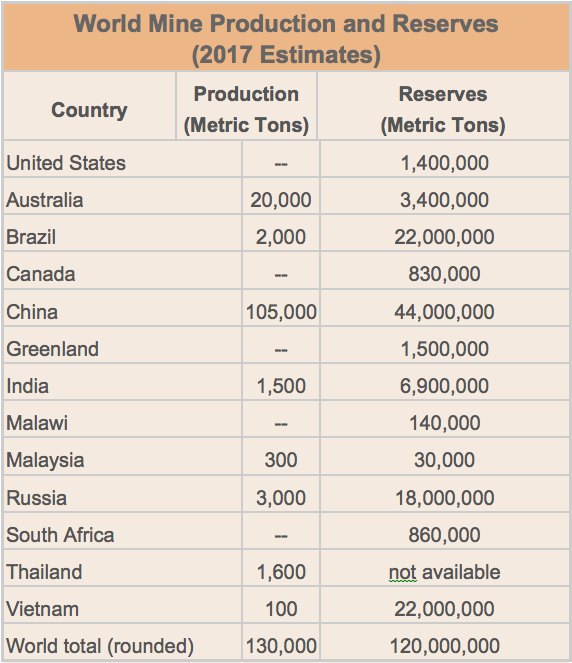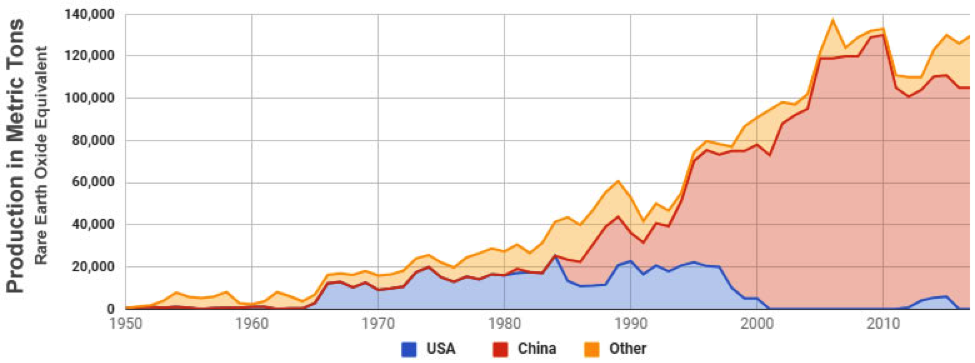Rare earth minerals—a group of 17 elements with similar qualities—are used in hundreds of high-technology products and military equipment. Military uses include night-vision goggles, precision-guided weapons, communications equipment, GPS equipment, batteries, and other defense electronics. Rare earth minerals are also used in making very hard alloys for armored vehicles and projectiles that shatter upon impact. Non-military uses include smartphones, flat screen TVs, electric car batteries, catalytic converters in automobiles, wind turbines, and solar panels.
China controls about 90 percent of the global trade in rare earth minerals. Beginning in the 1990s, China began dumping low-priced minerals on the global market and driving other miners, including U.S. miners, out of business. China became the world’s largest producer of rare earth minerals because of its non-existent environmental regulations and low processing costs.
According to the U.S. Geological Survey, between 2014 and 2017, the U.S. imported 80 percent of its rare earth minerals from China. The estimated value of those imports in 2018 was $160 million—up 17 percent from 2017 levels of $137 million. While this may seem small in the field of international trade and trade with China specifically, it is important to know that most of these products cannot be made without these minerals, at least at this time.
Despite controlling the export market, China only controls 37 percent of the world’s estimated rare earth mineral reserves. Congress and President Trump have taken actions to try to alleviate the imbalance but little has been accomplished and clearly more needs to be done, particularly in the light of the continuing trade disputes between the two countries.

Rare Earth Mineral Production
The United States entered the rare earth mineral market in the mid-1960s when color television demand exploded. But China began selling rare earth minerals at very low prices in the late 1980s and early 1990s, hastening the closure of U.S. mines that could no longer make a profit. Rare earth mineral prices skyrocketed in 2010 when China cut exports, which motivated new production outside of China—in the United States, Australia, Russia, Thailand, Malaysia, and other countries. But onerous regulations in the United States stopped rare earth production in 2015 when the only remaining mine, Mountain Pass Mine in San Bernardino County, California, filed for bankruptcy. (See graph below.) Last year, the United States resumed domestic mining of bastnaesite at this facility.
Rare Earth Mineral Production, 1950-2017

Lawmakers Take Action
Because our dependence on rare earth minerals is a national security issue, President Donald Trump issued an executive order in late 2017 to boost rare earth mineral development, which was followed by the Interior Department issuing its critical minerals list in early 2018 that included rare earth minerals.
Senators Lisa Murkowski of Alaska and Joe Manchin of West Virginia introduced bipartisan legislation this past April to facilitate technology needed to extract rare earth elements from coal. The Manchin-Murkowski bill would provide $23 million annually through 2027 to a rare earth extraction pilot project run by the West Virginia University and National Energy Technology Laboratory. Rare earth minerals are often found as part of other mining operations. Someone seeking copper, for example, may find small amounts of rare earth minerals that can be mined. As mining has been targeted by environmental groups in the United States, fewer mines of any kind are operating, leaving fewer opportunities to access accompanying trace minerals.
In the House, Rep. Mark Amodei of Nevada introduced legislation to streamline mining permitting and limit the ability of activists to block projects critical to national security.
Conclusion
Because production of rare earth minerals is a national security issue, the United States needs to have a domestic industry to produce these minerals. Being 80-percent dependent on China for them is clearly a problem when China and the United States are in a trade dispute. The United States won the oil battle with OPEC with respect to our domestic oil needs due to hydraulic fracturing and horizontal drilling technology. We can do the same with rare earth minerals as long as onerous regulations are held in abeyance. If those regulations impede exploration, the minerals will never be mined and our dependence may grow. That poses a threat to our military capabilities and even threatens the very wind and solar technologies the groups that oppose mining tend to support.
___________________________________________________________________________________
Further reading on the environmental impacts of rare earth metal production in China is available here.



